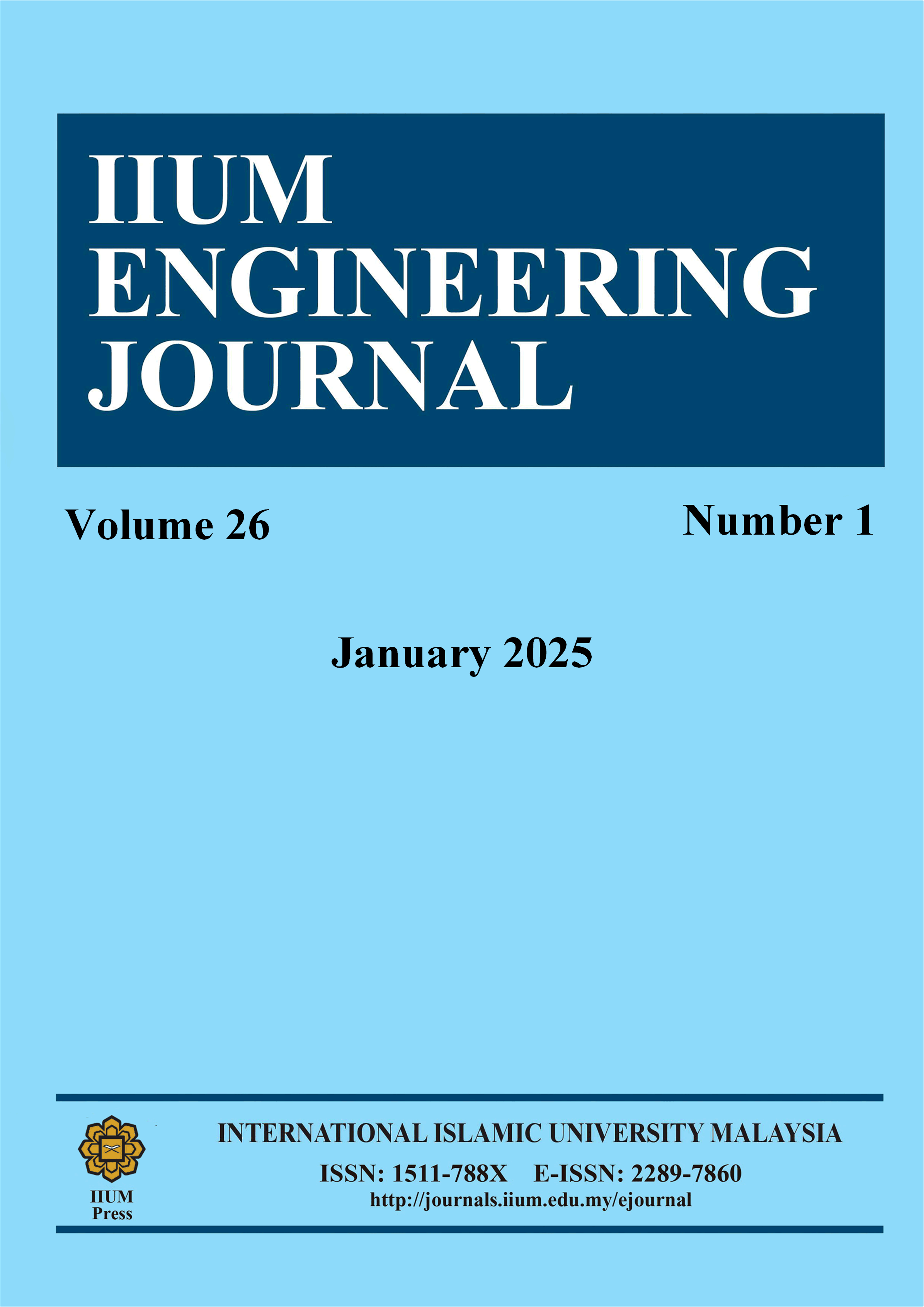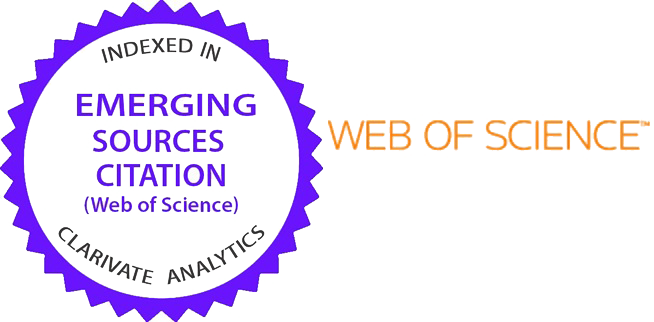Physical and Mechanical Properties of Green Cementless Mortar Incorporating Waste Paper Sludge Ash
DOI:
https://doi.org/10.31436/iiumej.v26i1.3015Keywords:
geopolymer, waste paper sludge ash, NaOH, Na2SiO3Abstract
As an alternative to conventional construction material such as normal concrete, waste paper sludge ash (WPSA) based geopolymer is seen as a promising and viable option in construction material selection due to its high amount of aluminum (Al) and silicon (Si) content. This research aims to determine the microstructure and mechanical characteristics of WPSA in geopolymers. The alkaline solution that contains 6 M of sodium hydroxide (NaOH) and sodium silicate (Na2SiO3) was used to activate the geopolymer. The hardened 50 mm-sized mortars were prepared and underwent a heat-cured process for 1 day at various temperatures at 24 ?, 60 ?, and 90 ?, respectively. Then, the mortar cubes were placed in the laboratory until the testing days. A compression test was conducted to identify the strength development of the WPSA-based geopolymer mortar at 7, 14, and 28 days, respectively. Chemical composition was analyzed using X-ray fluorescence (XRF). Furthermore, Fourier-transformed infrared spectroscopy (FTIR) was conducted to ascertain the structural elucidation and scanning electron microscope (SEM) analysis was done to provide microstructural observations of the geopolymer. Based on the XRF analysis, the WPSA has the highest amount of calcium oxide (CaO) instead of aluminum oxide (Al2O3) and silicon dioxide (SiO2), and it reduces the performance of WPSA as a cement replacement material. The ratio of SiO2 and Al2O3 is recorded as 1.1:1. Therefore, it is suitable for bricks and ceramics production instead of concrete production. As for the curing process, the heat-cured method is evident in accelerating strength development in the WPSA-based geopolymer mortar compared to the ambient curing method due to the rapid polymerization process in the geopolymer system. It is proven that 60 ? is the optimum temperature for the curing process for geopolymer mortar.
ABSTRAK: Sebagai salah satu alternatif kepada bahan binaan konvensional seperti konkrit biasa, geopolimer berasaskan abu enap cemar kertas (WPSA) adalah dilihat sebagai pilihan yang baik kerana bahan ini mempunyai kandungan aluminium (Al) and silika (Si) yang tinggi. Penyelidikan ini bertujuan untuk menentukan struktur mikro dan ciri mekanikal WPSA dalam geopolimer. Larutan alkali yang mengandungi 6 M natrium hidroksida (NaOH) dan natrium silikat (Na2SiO3) digunakan untuk mengaktifkan geopolimer. Mortar yang bersaiz 50 mm telah disediakn dan ia melalui proses pengawetan haba selama 1 hari pada suhu yang berza-beza, iaitu 24 ?, 60 ?, and 90 ?. Kemudian, kiub mortar tersebut diletakkan di dalam makmal sehingga hari ujian. Ujian mampatan dijalankan untuk mengenal pasti perkembangan kekuatan mortar geopolimer apabila mencapai 7, 14, dan 28 hari. Komposisi kimia dalam sampel telah dianalisa menggunakan pendarfluor sinar-X (XRF). Tambahan pula, Spektroskopi inframerah fourier transformasi (FTIR) untuk memastikan sifat bahan dan analisis pengimbasan mikroskop elektron (SEM) untuk menyediakan pemerhatian struktur mikro geopolimer. Berdasarkan data dari analisa XRF, WPSA mempunyai jumlah kalsium oksida (CaO) tertinggi berbanding aluminium oksida (Al2O3) dan silikon dioksida (SiO2), dan ia mengurangkan prestasi WPSA sebagai bahan gantian simen. Nisbah SiO2 dan Al2O3 direkodkan sebagai 1.1:1. Oleh itu, ia sesuai digunakan untuk pengeluaran batu bata dan seramik berbanding pengeluaran konkrit. Bagi proses pengawetan, kaedah pengawetan haba terbukti mempercepat perkembangan kekuatan geopolimer berasaskan WPSA berbanding pengawetan pada suhu ambien disebabkan berlakunya proses pempolimeran yang sangat pantas dalam sistem geopolimer tersebut. Telah terbukti bahawa suhu 60 ? adalah suhu optimum bagi proses pengawetan mortar geopolimer berasaskan WPSA ini.
Downloads
Metrics
References
P. Abhilash, C. Sashidhar, and I. V. Ramana Reddy, “Strength properties of fly ash and GGBS based geo-polymer concrete,” Int. J. ChemTech Res., vol. 9, no. 3, pp. 350–356, 2016.
B. Nagashree, V. Kishore, and M. Malathi, “Studies on geopolymerisation Reaction using synthesised activators,” Int. J. Innov. Res. Sci. Eng. Technol., vol. 6, no. 11, 2017.
G. Lavanya and J. Jegan, “Durability Study on High Calcium Fly Ash Based Geopolymer Concrete,” Adv. Mater. Sci. Eng., vol. 2015, 2015, doi: 10.1155/2015/731056. DOI: https://doi.org/10.1155/2015/731056
S. Ahmad, “Study of Concrete Involving Use of Waste Paper Sludge Ash as Partial Replacement of Cement,” IOSR J. Eng., vol. 3, no. 11, pp. 06–15, 2013, doi: 10.9790/3021-031130615. DOI: https://doi.org/10.9790/3021-031130615
B. Singh, G. Ishwarya, M. Gupta, and S. K. Bhattacharyya, “Geopolymer concrete: a review of some recent developments,” Constr. Build. Mater., vol. 85, pp. 78–90, 2015, doi: 10.3390/su11164394. DOI: https://doi.org/10.1016/j.conbuildmat.2015.03.036
N. B. Singh and B. Middendorf, “Geopolymers as an alternative to portland cement: an overview,” Constr. Build. Mater., vol. 237, p. 117455, 2020, doi: 10.1016/j.conbuildmat.2019.117455. DOI: https://doi.org/10.1016/j.conbuildmat.2019.117455
Z. M. Zahib, K. Kamaruddin, and H. Saman, “Strength performance of blended ash based geopolymer mortar,” in E3S Web of Conferences, 2018, vol. 34, p. 01016, doi: 10.1051/e3sconf/20183401016. DOI: https://doi.org/10.1051/e3sconf/20183401016
M. A. Kamaruddin, M. S. Yusoff, L. M. Rui, A. M. Isa, M. H. Zawawi, and R. Alrozi, “An overview of municipal solid waste management and landfill leachate treatment: Malaysia and Asian perspectives,” Environ. Sci. Pollut. Res., vol. 24, no. 35, pp. 26988–27020, 2017, doi: 10.1007/s11356-017-0303-9. DOI: https://doi.org/10.1007/s11356-017-0303-9
C. Aciu, D. A. I. Varvara, N. Cobirzan, and A. Balog, “Recycling of Paper Waste in the Composition of Plastering Mortars,” Procedia Technol., vol. 12, pp. 295–300, 2014, doi: 10.1016/j.protcy.2013.12.489. DOI: https://doi.org/10.1016/j.protcy.2013.12.489
H. Y. Zhang, J. C. Liu, and B. Wu, “Mechanical properties and reaction mechanism of one-part geopolymer mortars,” Constr. Build. Mater., vol. 273, 2021, doi: 10.1016/j.conbuildmat.2020.121973. DOI: https://doi.org/10.1016/j.conbuildmat.2020.121973
G. U. Alaneme, K. A. Olonade, and E. Esenogho, Eco-friendly agro-waste based geopolymer-concrete: a systematic review, vol. 3, no. 1. Springer International Publishing, 2023. DOI: https://doi.org/10.1007/s43939-023-00052-8
Z. Podolsky, J. Liu, H. Dinh, J. H. Doh, M. Guerrieri, and S. Fragomeni, “State of the art on the application of waste materials in geopolymer concrete,” Case Stud. Constr. Mater., vol. 15, no. July, p. e00637, 2021, doi: 10.1016/j.cscm.2021.e00637. DOI: https://doi.org/10.1016/j.cscm.2021.e00637
R. A. Antunes Boca Santa, A. M. Bernardin, H. G. Riella, and N. C. Kuhnen, “Geopolymer synthetized from bottom coal ash and calcined paper sludge,” J. Clean. Prod., vol. 57, pp. 302–307, 2013, doi: 10.1016/j.jclepro.2013.05.017. DOI: https://doi.org/10.1016/j.jclepro.2013.05.017
S. Yan and K. Sagoe-Crentsil, “Evaluation of fly ash geopolymer mortar incorporating calcined wastepaper sludge,” J. Sustain. Cem. Mater., vol. 5, no. 6, pp. 370–380, 2016, doi: 10.1080/21650373.2016.1174962. DOI: https://doi.org/10.1080/21650373.2016.1174962
B. V. Rangan et al., “Properties of wastepaper sludge in geopolymer mortars for masonry applications,” Constr. Build. Mater., vol. 53, no. 1, pp. 275–279, 2018, doi: 10.3390/su11164394. DOI: https://doi.org/10.3390/su11164394
M. A. Faris et al., “Assessment of alkali activated geopolymer binders as an alternative of portlant cement,” Mater. Plast., vol. 54, no. 1, pp. 145–154, 2017.
A. Newman, N. I. Halim, M. N. Muhd Sidek, H. Mohd Saman, and A. Alisibramulisi, “Enhancement of High Strength Concrete Performance By Utilising Nano Waste Paper Sludge Ash,” Sci. Res. J., vol. 18, no. 2, pp. 89–101, 2021, doi: 10.24191/srj.v18i2.11398. DOI: https://doi.org/10.24191/srj.v18i2.11398
R. P. Venkatesan and K. C. Pazhani, “Strength and durability properties of geopolymer concrete made with ground granulated blast furnace slag and black rice husk ash,” KSCE J. Civ. Eng., vol. 20, no. 6, pp. 2384–2391, 2016, doi: 10.1007/s12205-015-0564-0. DOI: https://doi.org/10.1007/s12205-015-0564-0
Chand, M.V.L.G., “Experimental Investigation on Geo Polymer,” vol. 5, no. 8, pp. 164–173, 2020.
N. Rahman, A. Kusbiantoro, N. Mamat, K. Muthusamy, and M. M. A. B. Abdullah, “Roles of calcium in geopolymer containing paper mill sludge ash,” Mater. Sci. Forum, vol. 917 MSF, no. 2013, pp. 311–315, 2018, doi: 10.4028/www.scientific.net/MSF.917.311. DOI: https://doi.org/10.4028/www.scientific.net/MSF.917.311
N. Mamat, A. Kusbiantoro, and N. Rahman, “Hydrochloric acid based pre-treatment on paper mill sludge ash as an alternative source material for geopolymer,” Mater. Today Proc., vol. 5, no. 10, pp. 21825–21831, 2018, doi: 10.1016/j.matpr.2018.07.038. DOI: https://doi.org/10.1016/j.matpr.2018.07.038
H. K. Steven, Beatrix.K, and C. P. William, Design and Control Design and Control of concrete mixtures. 2002.
F. A. Shilar, S. V. Ganachari, V. B. Patil, T. M. Y. Khan, and S. Dawood Abdul Khadar, “Molarity activity effect on mechanical and microstructure properties of geopolymer concrete: A review,” Case Stud. Constr. Mater., vol. 16, no. March, p. e01014, 2022, doi: 10.1016/j.cscm.2022.e01014. DOI: https://doi.org/10.1016/j.cscm.2022.e01014
S. Y. Kwek, H. Awang, and C. B. Cheah, “Influence of liquid-to-solid and alkaline activator (Sodium silicate to sodium hydroxide) ratios on fresh and hardened properties of alkali-activated palm oil fuel ash geopolymer,” Materials (Basel)., vol. 14, no. 15, 2021, doi: 10.3390/ma14154253. DOI: https://doi.org/10.3390/ma14154253
Y. Zhang, H. Li, A. Abdelhady, J. Yang, and H. Wang, “Effects of specimen shape and size on the permeability and mechanical properties of porous concrete,” Constr. Build. Mater., vol. 266, 2021, doi: 10.1016/j.conbuildmat.2020.121074. DOI: https://doi.org/10.1016/j.conbuildmat.2020.121074
A. Wongsa, K. Boonserm, C. Waisurasingha, V. Sata, and P. Chindaprasirt, “Use of municipal solid waste incinerator (MSWI) bottom ash in high calcium fly ash geopolymer matrix,” J. Clean. Prod., vol. 148, pp. 49–59, 2017, doi: 10.1016/j.jclepro.2017.01.147. DOI: https://doi.org/10.1016/j.jclepro.2017.01.147
A. A. Adam and Horianto, “The effect of temperature and duration of curing on the strength of fly ash based geopolymer mortar,” Procedia Eng., vol. 95, no. Scescm, pp. 410–414, 2014, doi: 10.1016/j.proeng.2014.12.199. DOI: https://doi.org/10.1016/j.proeng.2014.12.199
D. D. Sakthidoss and T. Senniappan, “A Study on High Strength Geopolymer Concrete with Alumina-Silica Materials Using Manufacturing Sand,” Silicon, vol. 12, no. 3, pp. 735–746, 2020, doi: 10.1007/s12633-019-00263-w. DOI: https://doi.org/10.1007/s12633-019-00263-w
B. Bhushan Jindal, “Development of High Strength Fly Ash based Geopolymer Concrete with Alccofine,” IOSR J. Mech. Civ. Eng., vol. 01, no. 01, pp. 55–58, 2016, doi: 10.9790/1684-15010010155-58. DOI: https://doi.org/10.9790/1684-15010010155-58
B. R. Rajan and K. Ramujee, “Strength & Development of Fly ash and GGBS Based Geopolymer Mortar,” vol. 07, no. 03, pp. 42–45, 2015.
Downloads
Published
How to Cite
Issue
Section
License
Copyright (c) 2025 IIUM Press

This work is licensed under a Creative Commons Attribution-NonCommercial 4.0 International License.
Funding data
-
Ministry of Higher Education, Malaysia
Grant numbers FRGS/1/2019/TK06/UIAM/03/1






















